
by Deep Green Resistance News Service | Feb 26, 2017 | Indigenous Autonomy, Obstruction & Occupation
Featured image: Protesters gathered at Los Encuentros, by Anna Watts
by Anna Watts / Intercontinental Cry
Indigenous communities across Guatemala have brought the country to a standstill for the second day in a row. Blockading major crossroads and highways, the nationwide peaceful demonstrations are protesting against the Guatemalan congress’s rejection of a constitutional reform that would legally recognize indigenous justice as part of the country’s judicial system.
An estimated 60 percent, or more than 6 million inhabitants, make up Guatemala’s population (IWGIA). Yet indigenous systems of justice, wherein local authorities rule on community issues, have been looked down upon by a country that continues to hugely discriminate against its majority indigenous population. The reforms face opposition from conservatives and major businesses that control most of Guatemala’s land and economy. Although many of these business interests campaigned against the reforms under the guise of fearing “legal confusion,” indigenous activists and leaders at the protests describe the opposition as deriving from a fear of losing any of their elite power to those who have been oppressed and exploited for centuries–Indigenous Peoples.
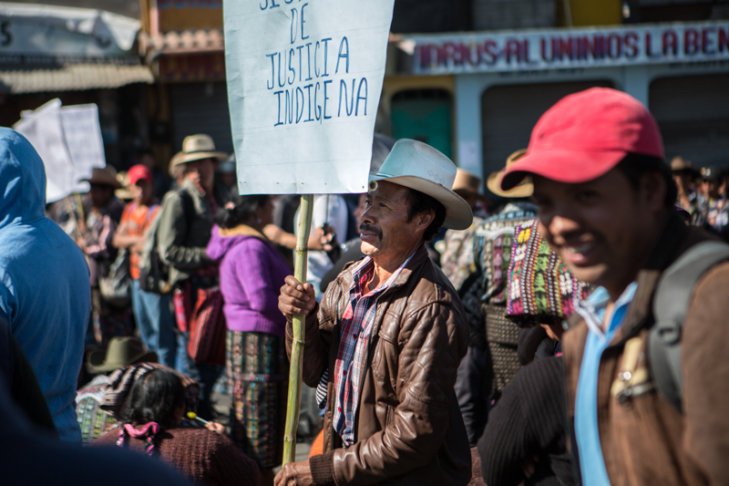
Photo: Anna Watts
At Los Encuentros, one of the most important crossroads between major cities located along the Pan-American Highway, thousands of indigenous people of the Sololá region gathered to participate in the blockades. Carrying handmade signs and led by their respective indigenous leaders, community groups unloaded from packed cargo trucks and chicken buses, carrying ready-made lunches to last through a full day of protesting.
By 8:30 AM, every tienda, comedor, and tortilla stand had been closed down and locked up, a rare sight for the ever-bustling highway hub. The majority indigenous city of Sololá was deserted; not a car in sight nor shop windows open. Pick-up trucks and makeshift blockades of boulders and large tree branches cut off traffic between smaller communities surrounding Lake Atitlán.
Protesters organized and coordinated solely by means of meetings and phone calls between indigenous community leaders. Use of Internet or social media to communicate and gain protest support was entirely avoided out of fear of vulnerability and tracking by police and those opposing the reforms. This distrust was reflected in weak media coverage of the protests; in spite of the thousand plus standing in solidarity at Los Encuentros, only one reporter from a local agency showed up with a small video camera.
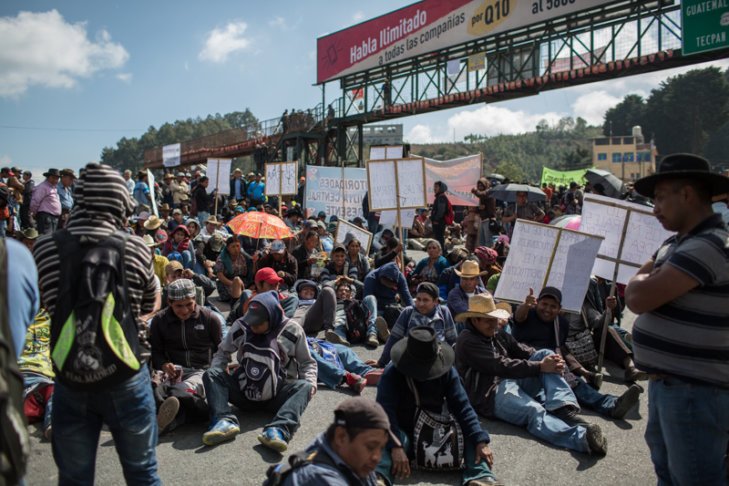
Photo: Anna Watts
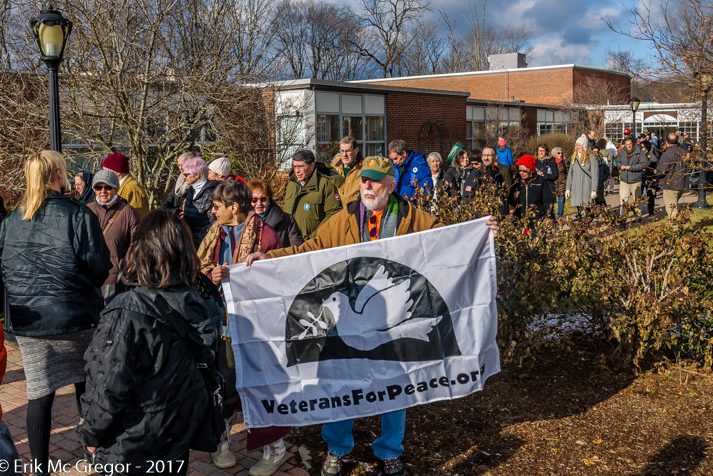
by Deep Green Resistance News Service | Jan 7, 2017 | Obstruction & Occupation
by ResistAim
Cortlandt, NY — On Friday morning – in front of a packed courtroom of over 100 New York residents, activists, sympathizers and supporters opposed to Spectra’s “AIM” Pipeline – Cortlandt Town Court Judge Daniel McCarthy issued sentences for nine New York residents (known as the “Montrose 9”) that were arrested for blocking access to a Spectra Energy construction yard in November 2015. Each of the nine of the defendants were fined and sentenced to community service. The defendants had pled the “Necessity Defense,” arguing that their activity was justified because it was done to stop a danger more harmful than the violation of the law, and only after all other legal and regulatory options had been exhausted. The danger they oppose is Spectra’s “AIM” Pipeline, a high-pressure 42-inch gas pipeline that runs within 105 feet of critical Indian Point Nuclear Power Plant safety facilities. Even though Judge Daniel Murphy ultimately rejected this argument, it is groundbreaking for the necessity defense to be considered, and the community stands with the “Montrose 9.” The defendants’ lawyer, Martin Stolar, has filed an appeal with the appellate division of Westchester’s Supreme Court.
Despite their sentencing, the activists vowed that the fight is not over and that the resistance movement will continue. As “Montrose 9” defendant Linda Snider stated, “It‘s difficult for me to think of myself as ‘guilty’ when I was trying to stop a possible catastrophe. The first part of the Spectra pipeline is now in place and running under the Hudson, right next to a proposed oil barge anchorage site and Indian Point Nuclear Power Plant in Tompkins Cove. What could go wrong? The huge outcry against this and other pipelines lead me to believe that the entire Spectra pipeline will, in the end, never get completed.” Defendant Susan Rutman agreed, stating: “Our communities need champions to protect the citizens, not punish those of us who are taking action and standing up to try to prevent a Fukushima-on-the-Hudson catastrophe. It is with a very sad heart that I stand before you to be sentenced.” Defendant Melissa Friedman stressed, “As an attorney, mother of two and with an ailing partner, I have limited time but I had to do something,” citing a long list of problems related to fracking and climate change. She added, “We’re doomed and it’s time to start acting like it.”
By completing the AIM Pipeline, Spectra Energy has only completed one-third of their overall pipeline expansion project – the “Algonquin” Pipeline Expansion. This is really one pipeline project disguised as three pipelines in order to illegally circumvent Spectra Energy’s obligation to identify cumulative impacts of the project as a whole. So while the AIM battle is over, the Montrose 9 voiced their commitment to winning the overall war in court on Friday.
Defendant Monica Hunken stated to the Judge, “Although we have been found guilty, it will not deter us from continuing to peacefully fight the next two segments of the Spectra pipeline every inch of the way. Whatever punishment we receive is a small price to pay for defending the land, air, water and our precious communities…We are here doing our job, being shepherds of the land. If we do not stand up to corporations, they will mow us down. We cannot allow them to treat us like we are sacrifice zones. I am doing this for you and your family too.”
The “AIM” pipeline has been opposed by local residents, countless local officials, Governor Cuomo, Senator Schumer and Senator Gillibrand, as well as riddled with corruption exposés and conflicts of interest. On February 29, 2016, New York State Governor Andrew Cuomo called for an immediate halt to construction while the state conducts an independent risk assessment; the Federal Energy Regulatory Commission (FERC) denied the Governor’s request. On August 3, 2016, both New York Senators Schumer and Gillibrand wrote to FERC, calling for an immediate halt to construction of the pipeline; FERC also denied the Senators’ request. In November 2016, it was revealed publicly that Phil Suter, the spouse of high-ranking FERC official Maggie Suter – who led the review for two gas pipeline projects by Spectra Energy – is a paid consultant for Spectra on a related pipeline project. Without further regulatory action or support from elected officials, residents and advocates have taken matters into their own hands to directly stop construction. Defendant Mike Bucci questioned the Judge, asking “All of the pieces of government have failed us, and now the judicial system has failed us. Where do we go for protection?”
Although FERC granted Spectra’s request to place the Stony Point to Yorktown portion of the AIM Pipeline into service in 2017, Spectra Energy still needs to complete its Atlantic Bridge and Access Northeast projects for the project to be financially viable. Resist Spectra and its allies across the northeast will oppose Spectra Energy’s reckless plans, rampant greed and toxic proposals at every stage. Factually, these pipelines and their supporting infrastructures are destructive and put tens-of-millions of lives, communities, and the ecosystems on which we depend at risk of imminent danger. As defendant Kathleen Thomas stated in court to Judge McCarthy today, “The response to our plea has to do with the word ‘imminent’. When the real danger is imminent, it will be too late. Once this becomes imminent, we are all gone. There will be no chance to say ‘I told you so’.” By working in solidarity with similar fights across the nation, we will stop Spectra once and for all.
Photos by Erik McGregor
Short video by Peter Eliscu
ResistAim online, on Facebook, and on Twitter
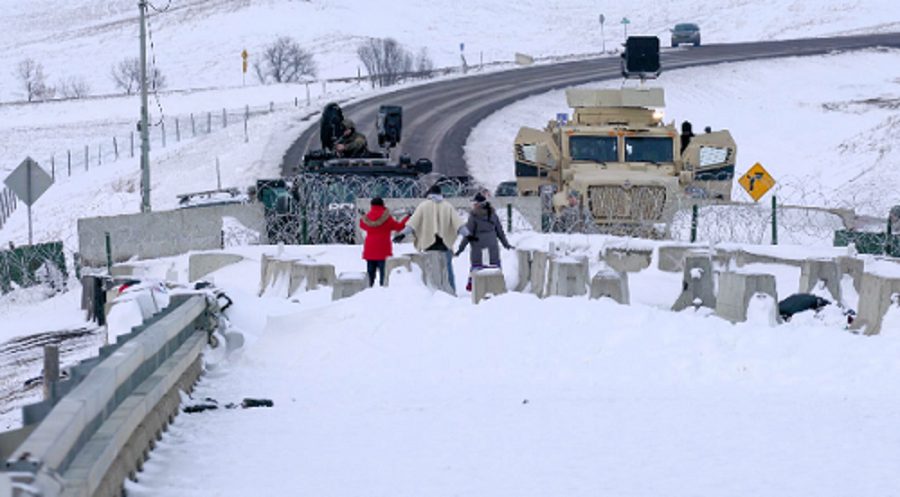
by Deep Green Resistance News Service | Dec 5, 2016 | Obstruction & Occupation
by Indigenous Environmental Network
Cannonball, ND – At approximately 3PM CST a group of about 30 people gathered to create a protective prayer line on the Backwater Bridge, the site of the November 20th attack on peaceful and unarmed water protectors by militarized police. Wesley Clark Jr., an organizer of Veterans Stand with Standing Rock, Kandi Mossett of the Indigenous Environmental Network, and Brenda White Bull who served 20 years in the Marine Corps and is also a direct descendant of Chief Sitting Bull, delivered a message to representatives of the National Guard, the Veterans Association, Tigerswan Private Security, who is hired by DAPL, and North Dakota law enforcement.
Wesley, Kandi, and Brenda walked together across the bridge to have a discussion with representatives on the other side. The purpose of the discussion was to clarify that the delegation of more than 2,000 veterans comes in peace and will remain nonviolent and in prayer during their visit to Standing Rock.
Further discussion was had about resolving tension between Water Protectors and law enforcement and also about the barricade on the bridge, which poses a danger not only to the camps but also the Cannon Ball community as it blocks the fastest route for emergency services. An audio recording of the meeting confirms that North Dakota law enforcement will not be entering the camp.
From December 4th through 7th, 2,000 veterans will descend on Standing Rock to act as a human shield for the water protectors on the front lines of the peaceful protest. The Veterans will also act as protectors of the Oceti Sakowin camp after the Army Corps of Engineers and North Dakota Governor, Jack Dalrymple, have called for its December 5th evacuation.
For Live updates at Standing Rock and the Veterans’ visit, please follow Indigenous Rising Media on Facebook.
Featured image by Spencer Mann, Indigenous Rising Media
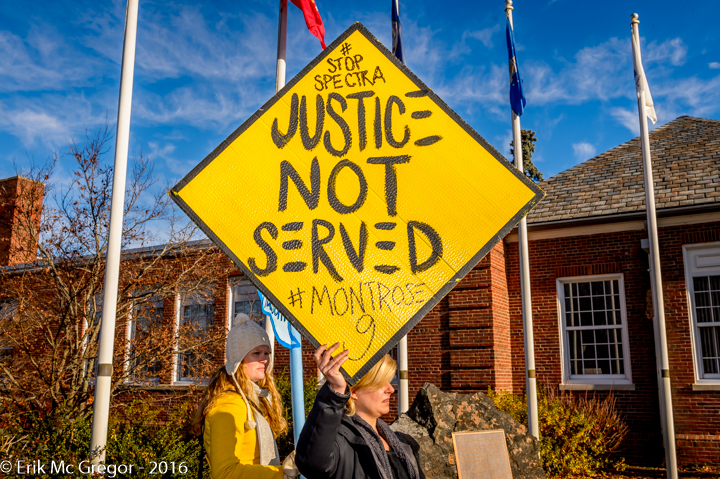
by Deep Green Resistance News Service | Dec 3, 2016 | Obstruction & Occupation
by ResistAIM
Cortlandt, NY — Four months after conclusion of the trial, today Judge Daniel McCarthy found the “Montrose 9” guilty of disorderly conduct for blocking traffic in Cortlandt Town Court. The “Montrose 9,” local residents and environmental advocates who were arrested for blocking access to a ware yard in Montrose to halt construction of Spectra Energy’s AIM pipeline on November 9, 2015, claimed that their actions were necessary to prevent a greater harm.
At the Press Conference after Judge McCarthy’s verdict, Defense Counsel, Martin Stolar, a prominent social justice attorney, said “I am extremely disappointed with respect to the necessity defense, which seems so obviously true. We will take it up on appeal. They (the defendants) are heroes, not criminals.”
After months of delay, testimony from the defendants ended on July 22, 2016. Many of the defendants expressed their concerns about global climate change and environmental damage from the fracked methane gas the pipeline will carry, fear of pipeline explosions and the possibility of another “Fukushima on the Hudson.”
Their goal at trial was to prove that the violation they committed – blockading Spectra from constructing a fracked gas pipeline – was necessary to prevent a greater harm. They demonstrated that Spectra Energy’s AIM pipeline presents immediate risks from explosions and impacts the health and safety of the community. Additionally, they noted that the fossil fuel industry is locking our nation into an unsustainable future of fossil fuels at a time when the country has to move towards renewable energy resources. They made clear that although members of the community had been diligently working through regulatory channels, their efforts were stymied by interminable delays and legal maneuvers, leaving them no recourse but to pursue non-violent direct action.
Although today’s ruling was not the outcome that many present had hoped for, the Montrose 9 and their allies said that they plan to continue the fight.
Marty Stolar: “Judge McCarthy’s verdict is guilty. The Judge rejects the justification as being speculative and the harm is not imminent or about to occur. He then rejects our First Amendment defense, and that the prosecution has proved its case beyond a reasonable doubt. The justification defense which he rejects, we all know, and you all know, the actions were justified, the harm is imminent, and the pipeline is extraordinarily dangerous, and constitutes a present harm and a present threat to every resident in this town, in this county and of the areas surrounding Indian Point. An appeal will be led after the sentence is imposed on January 6th.”
Susan Rutman: “It is absolutely staggering. This decision is disrespectful. But we will persevere. We cannot be thwarted by the limited scope of the legal system. He (the judge) wouldn’t even make a declaratory statement.”
Andrew Ryan: “This furthers my belief that we are run by a Corp-ocracy. They are people who care only about profits. They create and they interpret the law.”
For over three years, these concerned residents along with a number of groups in Westchester County, petitioned the Federal Energy Regulatory Commission (FERC) asking for an independent and transparent study to be done before allowing Spectra’s dangerous Algonquin Incremental Market (AIM) pipeline to be built. Their concerns, and those of elected officials at all levels of government, were ignored; FERC similarly dismissed the concerns of nuclear safety experts and pipeline experts. This refusal of FERC to acknowledge or address health and safety concerns meant that the local community had no legal or policy recourse, which supported their claim of necessity defense.
As of today’s date, Spectra still has not completed pipeline construction as the project has encountered environmental violations, noise complaints, and legal challenges. For months they have tried and failed to run the 42” pipeline under the Hudson River adjacent to Indian Point Nuclear Power Plant, with another attempt slated for this month. As a stop gap measure to bypass their failed river section and salvage the project, FERC granted permission to Spectra Energy to run additional gas through existing pipelines under the Hudson and Indian Point Nuclear Power Plant. This scenario, running additional gas through 50- and 60-year-old pipelines under the plant, was never examined by FERC or the Nuclear Regulatory Commission for safety and was not a condition granted in the FERC permit.
It is the latest in a string of examples of FERC’s failure to address safety concerns or act in the best interests of public heath and safety. In fact, today, members of ResistSpectra, Safe Energy Rights Group (SEnRG), and Stop the Algonquin Pipeline Expansion (SAPE) are in Washington DC attending The Peoples’ Hearing, where representatives of impacted communities will provide testimony and evidence of FERC’s abuses of power and law across the country. Their evidence will demonstrate to Congress the need to reform this rogue agency and reexamine their authority under the Natural Gas Act.
Find out more information about the AIM Pipeline and ongoing resistance here:
Online: www.resistaim.com
On Facebook: www.facebook.com/resistaim
On Twitter: https://twitter.com/ResistAIM
Photos by Erik McGregor
Video Andy Ryan: https://www.youtube.com/watch?v=UZLS_FIvK9Q
Video Kim Fraczek: https://www.youtube.com/watch?v=B0omT34SWw8&t=36s
by Deep Green Resistance News Service | Nov 27, 2016 | Obstruction & Occupation
Featured image: The Oceti Sakowin camp is currently home to thousands of water protectors and allies. (Photo: Reuters)
by Deirdre Fulton / Common Dreams
The U.S. Army Corps of Engineers on Friday informed Indigenous water protectors and their allies that they have nine days to vacate the main Dakota Access Pipeline protest camp—or else face arrest.
“This decision is necessary to protect the general public from the violent confrontation between protestors and law enforcement officials that have occurred in this area, and to prevent death, illness, or serious injury to inhabitants of encampments due to the harsh North Dakota winter conditions,” Col. John Henderson of the Corps said in a letter to the Standing Rock Sioux Tribe chairman Dave Archambault II.
The Oceti Sakowin camp, on the banks of the Cannonball River, will be closed Monday, December 5, the letter warned. Any individuals found on Army land north of the river after that date would be considered trespassing and could be prosecuted.
The Corps said it would establish a “free speech zone” south of the Cannonball River on Army lands.
But Dallas Goldtooth of the Indigenous Environmental Network (IEN), told the Bismarck Tribune that “there’s not enough land on the south side of the river where many are already camping; and a planned winter camp on 50 acres of reservation land near Cannon Ball is not yet ready, with groundbreaking set for next week.”
What’s more, he noted that “the eviction deadline is the day after more than 2,000 American war veterans are scheduled to arrive at the camp to stand in solidarity with Standing Rock,” the Tribune reports.
Archambault issued a statement in response to the Corps, saying the Standing Rock Sioux Tribe “is deeply disappointed in this decision by the United States, but our resolve to protect our water is stronger than ever.”
“It is both unfortunate and ironic that this announcement comes the day after this country celebrates Thanksgiving—a historic exchange of goodwill between Native Americans and the first immigrants from Europe,” he continued. “Although the news is saddening, it is not at all surprising given the last 500 years of the treatment of our people. We have suffered much, but we still have hope that the President will act on his commitment to close the chapter of broken promises to our people and especially our children.”
Indian Country Today reports:
The notice from the Army Corps comes less than a week after Morton County Sheriff’s deputies sprayed rubber bullets, mace and water on more than 400 people demonstrating at a bridge blockade not far from the camps. Temperatures were below freezing when protectors were repeatedly hosed down by police that Sunday night, November 20. There have also been reports that concussion grenades were fired at protectors. Dozens were hospitalized, including 21-year-old Sophia Wilansky, who may face the amputation of her arm, and Cheree Lynn Soloman, who is fundraising for eye surgery.
“If you were concerned about the safety of the fucking people you would have taken your ass out there and you would’ve cut their fucking hoses,” lamented Kash Jackson, an Army veteran from Michigan. His Facebook LIVE rant was broadcast shortly after the Corps announced its warning to water protectors that anyone choosing to stay on Corps land beyond December 5 would be doing so “at their own risk.”
“You stand firm, Standing Rock,” Jackson continued. “You stand firm right where you’re at. They want to push you off that land. It’s not their land to begin with.”
Meanwhile, IEN said in a statement: “We stand by our relatives of the Oceti Sakowin and reaffirm their territorial rights set in the Fort Laramie Treaty of 1851. If the Corps wants to keep people safe and prevent further harm, then deny the easement, rescind the permit, order a full Environmental Impact Statement, and send Department of Justice observers.”
“This decision by the Army Corps and the United States is short-sighted and dangerous,” the statement read. “We have already seen critical injuries cased by the actions of a militarized law enforcement. We implore President Obama and the White House to take corrective measures and to stop the Dakota Access Pipeline once and for all.”
The group, along with Honor the Earth, the International Youth Council, and the Camp of the Sacred Stones, is planning a news conference for Saturday afternoon, which IEN will live-stream from its Facebook page.
Filmmaker Josh Fox, who has been outspoken in his opposition to the crude oil pipeline, called the Corps’ eviction notice “a major act of aggression against basic rights of peaceful assembly and protest in the U.S. and constitutes a violation of treaties as well as the U.S. constitution’s guaranteed right to protest and assemble.”
“Oceti Sakowin, the main camp for water protectors, is a beautiful self-organizing community,” Fox continued. “It stands as not only the main place for the protest movement to assemble and organize, but it also represents a major leap forward for our combined movements for the environment, Indigenous sovereignty, and real democracy in America. If the Army Corps tears down this protest camp hundreds more will spring up in its place. A crucial alliance between indigenous values, native sovereignty and environmental movements has been forged here. We expect that the Standing Rock movement will find new and creative ways to fight the Dakota Access Pipeline no matter what, and that the Standing Rock movement and its alliances will find many areas of common ground and protest. We will fight fracking. We will fight pipelines.”
This article was originally published at Common Dreams, and re-published at Deep Green Resistance News Service under a Creative Commons license.

by Deep Green Resistance News Service | Nov 21, 2016 | Obstruction & Occupation, Repression at Home
by Indigenous Environmental Network
Cannon Ball – On November 20th at approximately 6PM CST over 100 Water Protectors from the Oceti Sakowin and Sacred Stone Camps mobilized to a nearby bridge to remove a barricade that was built by the Morton County Sheriff’s Department and the State of North Dakota. This barricade, built after law enforcement raided the 1851 treaty camp, not only restricts North Dakota residents from using the 1806 freely but also puts the community of Cannon Ball, the camps, and the Standing Rock Tribe at risk as emergency services are unable to use that highway.
Water Protectors used a semi-truck to remove two burnt military trucks from the road and were successful at removing one truck from the bridge before police began to attack Water Protectors with tear gas, water canons, mace, rubber bullets, and sound cannons.
At 1:30am CST the Indigenous Rising Media team acquired an update from the Oceti Sakowin Medic team that nearly 200 people were injured, 12 people were hospitalized for head injuries, and one elder went into cardiac arrest at the front lines. At this time, law enforcement was still firing rubber bullets and the water cannon at Water Protectors. About 500 Water protectors gathered at the peak of the non-violent direct action.

The following is a statement from the Indigenous Environmental Network:
“The North Dakota law enforcement are cowards. Those who are hired to protect citizens attacked peaceful water protectors with water cannons in freezing temperatures and targeted their weapons at people’s faces and heads.
“The Morton County Sheriff’s Department, the North Dakota State Patrol, and the Governor of North Dakota are committing crimes against humanity. They are accomplices with the Dakota Access Pipeline LLC and its parent company Energy Transfer Partners in a conspiracy to protect the corporation’s illegal activities.
“Anyone investing and bankrolling these companies are accomplices. If President Obama does nothing to stop this inhumane treatment of this country’s original inhabitants, he will become an accomplice. And there is no doubt that President Elect Donald Trump is already an accomplice as he is invested in DAPL”.








